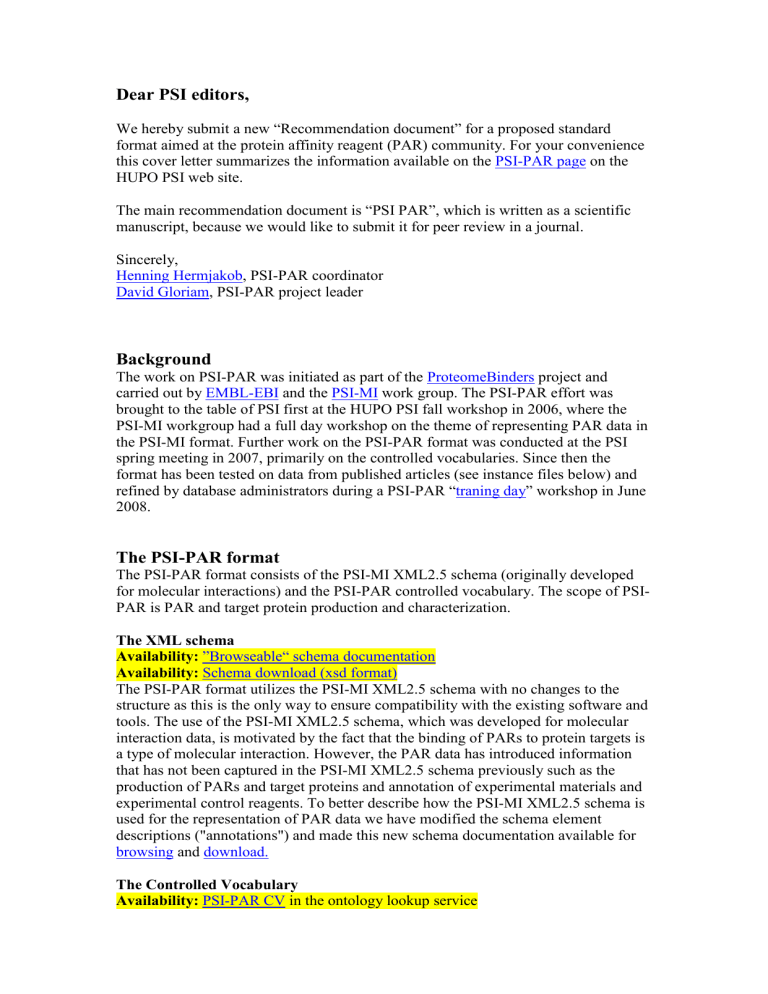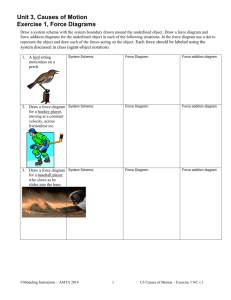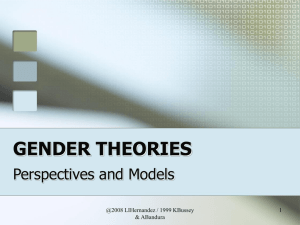PSI_submission_summary - HUPO Proteomics Standards

Dear PSI editors,
We hereby submit a new “Recommendation document” for a proposed standard format aimed at the protein affinity reagent (PAR) community. For your convenience this cover letter summarizes the information available on the PSI-PAR page on the
HUPO PSI web site.
The main recommendation document is “PSI PAR”, which is written as a scientific manuscript, because we would like to submit it for peer review in a journal.
Sincerely,
Henning Hermjakob , PSI-PAR coordinator
David Gloriam , PSI-PAR project leader
Background
The work on PSI-PAR was initiated as part of the ProteomeBinders project and carried out by EMBL-EBI and the PSI-MI work group. The PSI-PAR effort was brought to the table of PSI first at the HUPO PSI fall workshop in 2006, where the
PSI-MI workgroup had a full day workshop on the theme of representing PAR data in the PSI-MI format. Further work on the PSI-PAR format was conducted at the PSI spring meeting in 2007, primarily on the controlled vocabularies. Since then the format has been tested on data from published articles (see instance files below) and refined by database administrators during a PSI-PAR “ traning day
” workshop in June
2008.
The PSI-PAR format
The PSI-PAR format consists of the PSI-MI XML2.5 schema (originally developed for molecular interactions) and the PSI-PAR controlled vocabulary. The scope of PSI-
PAR is PAR and target protein production and characterization.
The XML schema
Availability:
”Browseable“ schema documentation
Availability: Schema download (xsd format)
The PSI-PAR format utilizes the PSI-MI XML2.5 schema with no changes to the structure as this is the only way to ensure compatibility with the existing software and tools. The use of the PSI-MI XML2.5 schema, which was developed for molecular interaction data, is motivated by the fact that the binding of PARs to protein targets is a type of molecular interaction. However, the PAR data has introduced information that has not been captured in the PSI-MI XML2.5 schema previously such as the production of PARs and target proteins and annotation of experimental materials and experimental control reagents. To better describe how the PSI-MI XML2.5 schema is used for the representation of PAR data we have modified the schema element descriptions ("annotations") and made this new schema documentation available for browsing and download.
The Controlled Vocabulary
Availability: PSI-PAR CV in the ontology lookup service
Availability: PSI-PAR CV download in obo format.
The PSI-PAR CV contains the majority of the terms from the PSI-MI CV and in addition approximately 200 new terms. The PSI-PAR CV can be browsed on the ontology lookup service (OLS) or downloaded in obo format. Apart from the PSI-
PAR CV the PSI-MI XML2.5 schema utilizes a number of external CVs/ontologies that can also be found on the OLS including the Gene Ontology, NCB I taxonomy ontology, BioSapiens Annotations and Unit Ontology. Information about which schema element that uses which CV is found in this table .
Instance examples
Availability: Link to the instance examples
We have produced 3 instance examples of data from published articles that have been captured in the PSI-PAR format.
Additional documentation and resources
Apart from the documents submitted for review by PSI there is also additional information that can be useful for reviewers.
The PSI-PAR web page
The PSI-PAR manuscript
User manual for the representation of PAR data in the PSI-PAR format
MIAPAR – Minimum Information about a Protein Affinity Reagent
Software and tools compatible with the PSI-XML2.5 schema







